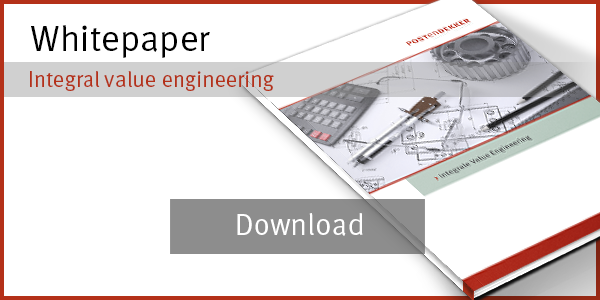
Integral value engineering is a method to reduce your cost price while maintaining the market value of your product. Focus is on reduction of integral costs while retaining form-fit-function, minimal time for re-qualification and short payback period of the endeavour.
With value engineering, the investments and risks are kept low and the lead time short. Also, there is already a client base, so there is no need to put in any effort in that. In this article, I will offer the necessary information for your future value engineering project.
We have written earlier about what integral value engineering exactly is, how you determine whether value engineering is interesting for your organisation, how you identify and define such a project and, finally, how to organise your value engineering project.
We have already given you tips for value engineering before. In brief, these were the tips:
Tip 1: put focus on solutions for which you do not need/or need only limited re-qualification;
Tip 2: isolate the project and collect ideas from the entire organisation;
Tip 3: create a possibility for practical research;
Tip 4: total saving from small ideas leads to a positive result;
Tip 5: weight reduction is the low hanging fruit.
You can read an explanation of the tips here.
Download the whitepaper 'Integral value engineering'
Case study value engineering: redesign of the TrimFlow
To show how a project is going in practice, it is good to use a case study.
Kverneland Group, manufacturer of agricultural machines, asked Post en Dekker to do a value engineering trajectory for their TrimFlow spreading machine. Starting point of the adjustment in the design, was retaining function, design, and interface with the spreader. Besides the design, production/purchase of components and the assembly of the TrimFlow were also open for reconsideration.
Post en Dekker began by determining the scope of the assignment. Starting point was the cost construction of the existing design of the TrimFlow, based on optimized production volumes. All costs for materials, work at suppliers and Kverneland itself, transportation, coating, packaging and stock, were taken into account.
A brainstorm session with representatives from Kverneland and Post en Dekker, resulted in various options for cost price reduction, from which it appeared that optimisation of the existing design led to savings.
For the validation of the various design modifications, Post en Dekker carried out several analyses and tests. Together with Kverneland, Post en Dekker tested prototypes based a redesign. Most important criteria were upholding the spread pattern and equal (or higher) strength and rigidity of the construction.
Result
A redesign of the steering plates resulted in a smaller number of manufactured parts, simplification of the construction of the pivot point of a plate, and the reduction of the number of welding joints.
After Kverneland had taken into production the new version of the TrimFlow, a cost price check was carried out for a period of six months. Based on the results of that, a new cost price was determined and with that – related to the previously performed baseline measurement – the cost price reduction that was obtained.
In the end, the project led to a cost reduction of 16,5 %. Read and download the complete case study here.
Factsheet value engineering
If you would like to begin with value engineering and need more inspiration, you can download the fact sheet value engineering. You will find the following here:
• Practical tables and charts regarding types of material costs;
• Information about outsourcing to foreign countries;
• Inspiration about reducing the cost price, function-integration and reducing the assembly costs.
You can download the factsheet for free on our website. Click on the button below for this.











